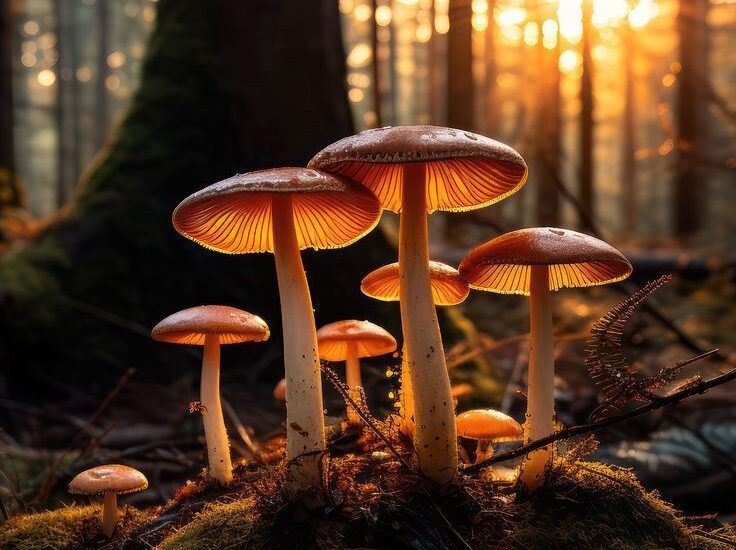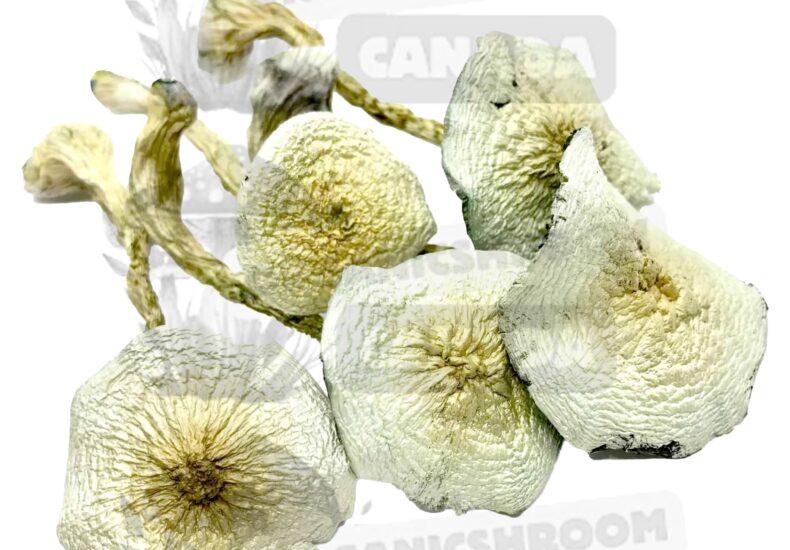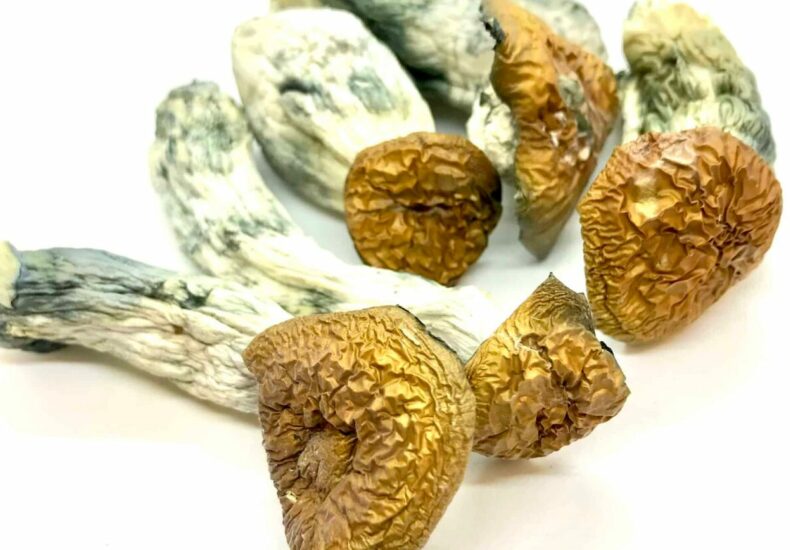
Are you curious about the mysterious world of South American Magic Mushrooms? Psilocybin, a key compound in these fungi, shows promise for treating mental health issues. This blog post will guide you through the fascinating aspects of these powerful mushrooms and their potential benefits.
Key Takeaways
- South American magic mushrooms are known for their potent psychoactive effects due to psilocybin and psilocin.
- Indigenous cultures in tropical and subtropical regions of South America have used these mushrooms in spiritual and religious practices for thousands of years.
- Scientists are studying psilocybin, the key compound in magic mushrooms, for its potential to treat mental health issues like depression, PTSD, and addiction.
- Clinical trials on the therapeutic uses of psilocybin show promising results, especially in treating depression by affecting brain connectivity patterns.
- Health Canada’s Special Access Program allows for legal access to psilocybin under strict criteria for therapeutic purposes.
Understanding Psilocybin

Psilocybin is a psychoactive compound found in magic mushrooms. The biosynthesis of tryptamine alkaloids in mushrooms underpins the production of psilocybin.
Alkaloid Chemistry
Alkaloids are a group of naturally occurring chemical compounds that contain basic nitrogen atoms. They often have significant pharmacological effects on humans and animals. Magic mushrooms, specifically those from South America, produce a unique type of alkaloid known as psilocybin, along with its close relative, psilocin.
These substances belong to the tryptamine category of alkaloids and play a key role in the mushroom’s hallucinogenic properties.
To identify these compounds in magic mushrooms, scientists use forensic analysis techniques such as capillary electrophoresis-mass spectrometry (CE-MS) and liquid chromatography-mass spectrometry (LC-MS).
These methods allow precise detection of psilocybin and psilocin levels within mushroom samples. Understanding the chemistry behind these alkaloids is crucial for both medical research into their therapeutic potential and legal efforts to control their use.
Biosynthesis of Tryptamine Alkaloids in Mushrooms
After exploring the basics of alkaloid chemistry, we delve into how mushrooms create tryptamine alkaloids like psilocybin. Mushrooms use simple compounds as building blocks to produce these complex chemicals.
They start with an amino acid called tryptophan. Enzymes inside the mushroom cells then add and modify parts of this molecule. This creates psilocybin, a substance that affects human brains profoundly.
Mushrooms do this through a series of biochemical reactions. These processes are finely tuned by nature over millions of years. Scientists study these pathways using tools like chromatography and mass spectrometry in forensic toxicology and clinical research settings.
This helps them understand how mushrooms can turn a common nutrient into powerful psychoactive substances.
Mushrooms craft their chemical arsenal meticulously, turning ordinary elements into extraordinary experiences.
The Origin of Magic Mushrooms

Magic mushrooms have been traced back to indigenous societies in tropical and subtropical regions. The Entheogenic Origins of Religion theory suggests that the use of magic mushrooms may have influenced ancient religious practices and spiritual beliefs in these cultures.
Indigenous to Tropical and Subtropical Regions
Magic mushrooms thrive in warm, moist climates found in tropical and subtropical regions. South America’s dense forests and varied climates create an ideal environment for these fascinating fungi to grow.
The region is home to more than 200 species of magic mushrooms, which have played a role in traditional practices for thousands of years.
The diverse ecosystems ranging from rainforests to coastal areas in South America support the growth of these potent hallucinogenic mushrooms. Each species possesses unique characteristics that contribute to their effects on the human mind and body.
Moving into the specifics of South American magic mushrooms will reveal more about their distinct properties and roles in various cultures.
South American Magic Mushrooms

South American magic mushrooms grow in specific regions and possess unique characteristics due to their distinct species. Their effects on mental and physical health have garnered attention for potential therapeutic uses through clinical trials and regulatory pathways such as Health Canada’s Special Access Program.
Explore the enigmatic world of South American magic mushrooms for a deeper understanding of their properties and applications!
Specific Species and Their Characteristics
Among the South American magic mushrooms, Psilocybe cubensis stands out for its large, golden caps. Farmers often find this species growing in cow and buffalo dung in moist climates.
Its size and distinctive look make it a favorite among those who buy shrooms online. People value it for its potent psychoactive effects, caused by high levels of psilocybin and psilocin.
Another notable species is Psilocybe azurescens, known for being one of the strongest mushrooms in terms of hallucinogenic power. It thrives in sandy soils, especially along coastlines or riverbanks.
Unlike Psilocybe cubensis, this mushroom prefers cooler temperatures and higher humidity. Its unique characteristics highlight the diversity within psychedelic substances found in nature.
Effects of Magic Mushrooms

Magic mushrooms can cause short-term mental effects and physical effects. Long-term effects are also a possibility.
Short-Term Mental Effects
Magic mushrooms can cause heightened emotions and hallucinations. They also lead to increased heart rate and blood pressure, as well as dry mouth, muscle weakness, and numbness.
These temporary mental effects are a result of the active compounds in magic mushrooms interacting with the brain’s neurotransmitters.
Short-Term Physical Effects
Magic mushrooms can cause short-term physical effects such as increased heart rate and blood pressure. These mushrooms may also lead to muscle twitches, nausea, dry mouth, hallucinations, heightened emotions, muscle weakness, and numbness.
The impact on the body includes a rise in heart rate and blood pressure along with disturbing sensations like muscle twitches and numbness. Conclusively, short-term physical effects of magic mushrooms encompass both physiological changes as well as sensory alterations that affect the body.
Moving forward to “Long-term Effects”, it is equally important to understand how the use of magic mushrooms shapes an individual’s health over an extended period.
Long-Term Effects
Researchers are exploring the potential long-term effects of psilocybin, including its use in treating various mental health disorders and addictions. This psychedelic compound is being studied for its impact on conditions such as depression, anxiety, PTSD, anorexia nervosa, and substance abuse.
Notably, Oregon has taken a significant step by passing legislation to regulate the therapeutic use of magic mushrooms for their potential long-term effects on mental health.
The classification of psilocybin as a Schedule I substance in many countries, including the U.S., following the 1971 United Nations Convention has limited research efforts into its long-term effects.
Risks Associated with Use of Magic Mushrooms
Using magic mushrooms can lead to substance use disorders and physical as well as psychological withdrawal. Understanding these risks is essential for making informed decisions about their use.
Substance Use Disorders
Substance use disorders can lead to a range of health problems and issues in everyday life. They are characterized by an inability to control the use of substances, leading to harmful consequences.
Individuals with substance use disorders may experience withdrawal symptoms when they attempt to cut down or stop using the substance. This can include physical symptoms such as tremors, sweating, and nausea, as well as psychological symptoms like anxiety, irritability, and intense cravings for the substance.
Understanding the impact of substance use disorders is crucial in developing effective interventions that address both physical and psychological aspects. By recognizing the signs and symptoms early on, individuals can receive timely support towards recovery and management of these conditions.
Physical and Psychological Withdrawal
Magic mushroom use can lead to physical and psychological withdrawal symptoms, including headaches, fatigue, mood swings, and irritability. In some cases, individuals may also experience anxiety and depression during the withdrawal process.
Withdrawal from magic mushrooms is a complex phenomenon with both physical and emotional dimensions that demand attention in treatment strategies.
Furthermore, studies have shown that psilocybin has potential therapeutic benefits for conditions like depression and addiction; however, its abuse can lead to negative health effects.
Potential Therapeutic Uses of Psilocybin
Research is showing promise in the potential therapeutic uses of psilocybin for mental health conditions, encouraging those interested to explore further.
Current Clinical Trials
Researchers are currently conducting clinical trials to investigate the potential therapeutic uses of psilocybin. Some of these trials are focused on the treatment of depression, smoking and alcohol addiction, anxiety in terminally ill patients, opioid dependence, PTSD, and anorexia nervosa. This research is examining how psilocybin affects the brain’s connectivity patterns, showing promising results for the treatment of depression.
- Clinical Trials for Treatment of Depression: Several clinical trials are underway to evaluate the effectiveness of psilocybin in treating depression. These trials aim to understand how psilocybin can alleviate depressive symptoms and improve overall mental health.
- Smoking and Alcohol Addiction Studies: Research is being conducted to assess the potential for psilocybin to help individuals overcome smoking and alcohol addiction. These trials seek to determine whether psilocybin therapy can aid in breaking addictive patterns.
- Anxiety in Terminally Ill Patients: Clinical trials are investigating the use of psilocybin to alleviate anxiety in terminally ill patients. The research aims to provide insights into how psilocybin can offer psychological support and comfort for individuals facing terminal illnesses.
- Opioid Dependence Research: Researchers are examining the potential of psilocybin in addressing opioid dependence. Clinical trials are exploring how psilocybin therapy may help individuals reduce their reliance on opioids and manage withdrawal symptoms.
- PTSD and Anorexia Nervosa Studies: Clinical trials are also focusing on understanding how psilocybin could benefit individuals with PTSD and anorexia nervosa. These studies aim to uncover potential therapeutic effects that may aid in managing these conditions.
- Brain Connectivity Patterns Research: Scientists are studying how psilocybin affects the brain’s connectivity patterns, particularly concerning its impact on neural networks associated with mood regulation and emotional processing.
- Promising Results for Depression Treatment: Preliminary findings from clinical trials suggest that alterations in brain connectivity patterns induced by psilocybin show promise for improving treatment outcomes for individuals with depression.
- Evaluation of Long-Term Effects: Current clinical trials prioritize assessing the long-term effects of psilocybin therapy, including its sustainability in managing various mental health conditions over extended periods.
- Impact on Neuroplasticity: Some clinical trials are centering on understanding how psilocybin influences neuroplasticity, potentially offering new avenues for developing interventions targeting psychiatric conditions based on this mechanism.
Health Canada’s Special Access Program
Health Canada’s Special Access Program provides a legal avenue for individuals to obtain psilocybin for therapeutic purposes. This program operates within the framework of the Controlled Drugs and Substances Act (CDSA) to regulate access, ensuring safe and legal use of psilocybin.
The criteria and regulations set by the program aim to safeguard its therapeutic usage. It stands as an essential component in Canada’s ever-evolving landscape of research and treatment for psilocybin and magic mushrooms.
Psilocybin through Health Canada\’s Special Access Program is subject to specific criteria and regulations aiming to ensure safe, regulated access for therapeutic uses, operating within the framework of the Controlled Drugs and Substances Act (CDSA).
Individual Subsection 56 (1) Exemptions
Individual Subsection 56 (1) Exemptions allow the Minister of Health to exempt substances for scientific, medical, or public interest purposes. Oregon has recently passed legislation to regulate legal therapeutic use of psilocybin, making it the first jurisdiction globally to do so.
This move highlights an increasing recognition of the potential therapeutic benefits and research opportunities associated with psychedelics like magic mushrooms.
Conclusion
Unveiling the mysteries behind South American magic mushrooms has shown promise for mental health treatment. Current studies are investigating psilocybin’s impact on brain connectivity, especially in treating depression.
The changing public perception and ongoing legislation indicate a paradigm shift towards therapeutic use and research. With Oregon leading the way in decriminalization and regulation, it’s an exciting time to explore the potential benefits of these enigmatic fungi.


